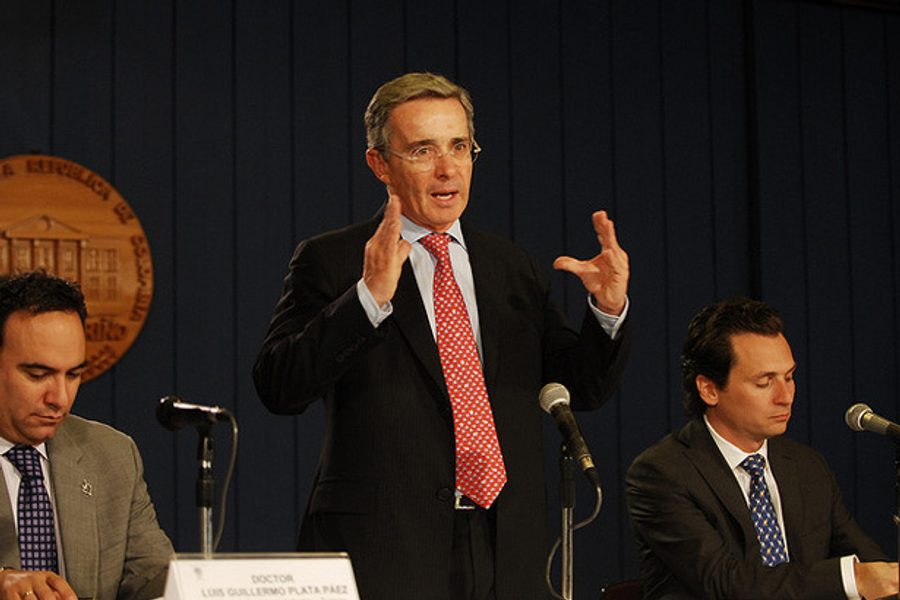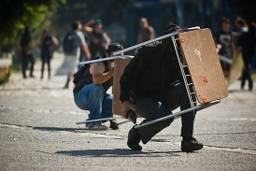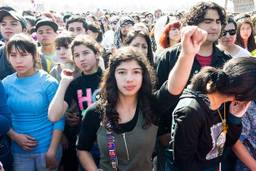
Colombia’s former president, Alvaro Uribe, recently leaked accounts of nascent peace talks between the current government and left-wing guerrillas embroiled in a civil war for nearly 50 years. The backroom negotiations signal a return to a peace process often stifled by paramilitary groups, U.S. “war on drugs” hardliners and Uribe himself.
The government of Colombian President Juan Manuel Santos, Uribe’s former defense minister, began setting expectations earlier this year by exploring how long guerrillas who lay down their arms might have to spend in prison and proposing compensation guidelines for those who had lost family members or land during the 48-year conflict. According to School of the Americas Watch, more than 3 million people have been displaced since the conflict began in 1964.
The generations-long battle between the government, right-wing factions and left-wing guerillas became intertwined with the international drug trade during the 1980s. Non-governmental forces on both the left and right receive funding from the cartels. The Revolutionary Armed Forces of Colombia (FARC), the largest left-wing guerrilla group, has escalated violent actions in the past year. “Terrorist” attacks were up by 53 percent in the first half of the year, according to the Colombia Defense Ministry. This has put more pressure on the government to seek a path to peace.
Uribe has tried to keep his successor on a short leash, and one Uribe confidant further undermined the process by calling the renewed talks “a leap in the dark.” But the new talks demonstrate Santos’ independent streak.
When Uribe took office in 2002, he brought a general’s zeal to eradicating the coca trade through violent government and paramilitary intervention, including mass-fumigation and military strikes. The U.S. government, which has always played a large role in Colombian politics, found a staunch ally in the right-wing former rancher, who became close friends with George W. Bush and was rewarded for being the only Latin American president to contribute forces to the “coalition of the willing” in Iraq.
Plan Colombia, a 10-year, $7.5 billion counternarcotics program carried out by the U.S.-trained Colombia military, became a centerpiece of the North American “war on drugs” during the late 1990s. The United States provided the bulk of the military aid and training, with some minority help from European Union nations. This made Colombia the third-largest recipient of U.S. foreign funding from 2001-2007, behind only Israel and Egypt.
Human rights groups have criticized Plan Colombia for indiscriminately killing civilians in attempts to eradicate the coca trade, including dressing up poor urban residents as left-wing guerrillas to make their combat efforts look more successful, especially to the plan’s foreign funders. Harsher critics have said the plan is a strategic tool to continue the Colombian government’s dependency on the United States.
Some U.S. politicians questioned the Bush administration’s unwavering commitment to Colombia, eventually balking at a second round of funding for the country’s role in the “war on drugs.”
The Obama government has taken a lighter approach to relations with the war-torn country, pushing a free trade agreement that went into effect this summer. Like Plan Colombia, the trade agreement was passed with a mandate to improve human and labor rights in the country with one of Latin America’s worst modern track records. But a field report released last week by the Washington Office on Latin America criticized Colombia’s lack of progress on the American-backed Labor Action Plan.
U.S. involvement in the free trade agreement was contingent on Colombia establishing a plan to improve worker protections and make steps toward prosecuting past crimes. Under the plan, Colombia promised to establish a new labor ministry, give workers the right to organize freely, and ensure the safety of union members targeted by paramilitary activity. The AFL-CIO calls Colombia “the most dangerous place to be a trade unionist” because organizing can often invite terror or death. According to the recent report, 30 Colombian trade unionsts have been killed and almost 500 threatened since the plan was passed in April 2011.
With declining approval ratings, President Santos fights an uphill battle to win peace. But he could succeed where his predecessors have failed, and that might concern Uribe as much as geopolitical considerations.
Jackson Foote is a Ph.D. student in mass communication at the University of Wisconsin-Madison. He studies the relationship between social movements and the media in the Americas.



